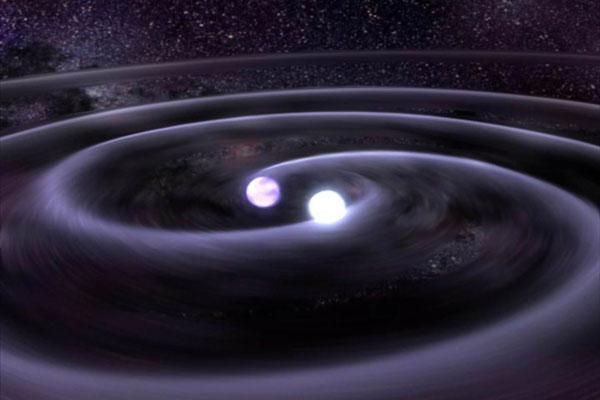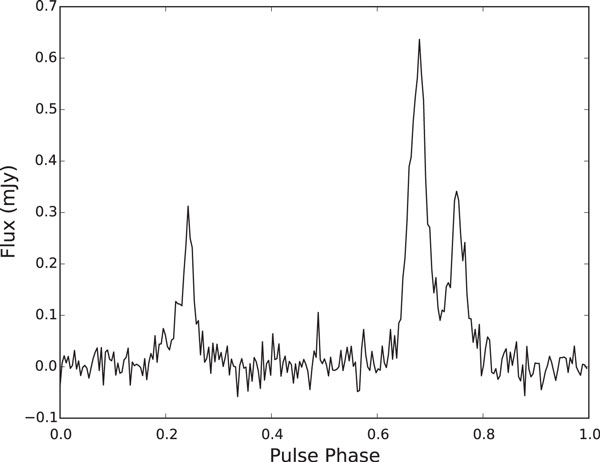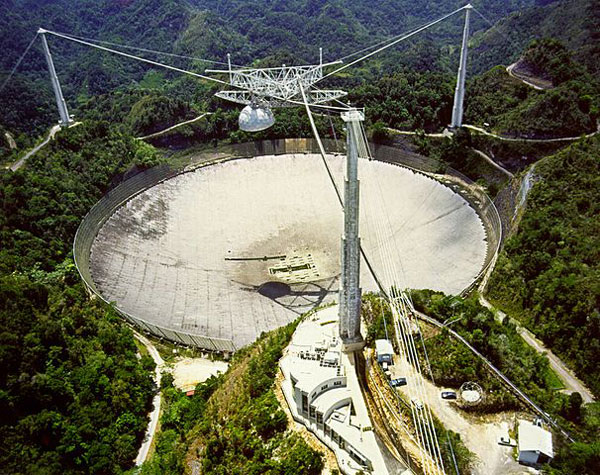Got any plans in 46 million years? If not, you should keep an eye out for PSR J1946+2052 around that time — this upcoming merger of two neutron stars promises to be an exciting show!

NASA/Goddard Space Flight Center
Survey Success

Stovall et al. 2018
It seems like we just wrote about the dearth of known double-neutron-star systems, and about how new surveys are doing their best to find more of these compact binaries. Observing these systems improves our knowledge of how pairs of evolved stars behave before they eventually spiral in, merge, and emit gravitational waves that detectors like the Laser Interferometer Gravitational-wave Observatory might observe.
Today’s study, led by Kevin Stovall (National Radio Astronomy Observatory), goes to show that these surveys are doing a great job so far! Yet another double-neutron-star binary, PSR J1946+2052, has now been discovered as part of the Arecibo L-Band Feed Array pulsar (PALFA) survey. This one is especially unique due to the incredible speed with which these neutron stars orbit each other and their correspondingly (relatively!) short timescale for merger.
An Extreme Example
The PALFA survey, conducted with the enormous 305-meter radio dish at Arecibo, has thus far resulted in the discovery of 180 pulsars — including two double-neutron-star systems. The most recent discovery by Stovall and collaborators brings that number up to three, for a grand total of 16 binary-neutron-star systems (confirmed and unconfirmed) known to date.

NOAO/AURA/NSF/H. Schweiker/WIYN
The newest binary in this collection, PSR J1946+2052, exhibits a pulsar with a 17-millisecond spin period that whips around its compact companion at a terrifying rate: the binary period is just 1.88 hours. Follow-up observations with the Jansky Very Large Array and other telescopes allowed the team to identify the binary’s location to high precision and establish additional parameters of the system.
PSR J1946+2052 is a system of extremes. The binary’s total mass is found to be ~2.5 solar masses, placing it among the lightest binary-neutron-star systems known. Its orbital period is the shortest we’ve observed, and the two neutron stars are on track to merge in less time than any other known neutron-star binaries: in just 46 million years. When the two stars reach the final stages of their merger, the effects of the pulsar’s rapid spin on the gravitational-wave signal will be the largest of any such system discovered to date.
More Tests of General Relativity
What can PSR J1946+2052 do for us? This extreme system will be especially useful as a gravitational laboratory. Continued observations of PSR J1946+2052 will pin down with unprecedented precision parameters like the Einstein delay and the rate of decay of the binary’s orbit due to the emission of gravitational waves, testing the predictions of general relativity to an order of magnitude higher precision than was possible before.
As we expect there to be thousands of systems like PSR J1946+2052 in our galaxy alone, better understanding this binary — and finding more like it — continue to be important steps toward interpreting compact-object merger observations in the future.
Citation
K. Stovall et al 2018 ApJL 854 L22. doi:10.3847/2041-8213/aaad06
Related Journal Articles
This post originally appeared on AAS Nova, which features research highlights from the journals of the American Astronomical Society.
 1
1









Comments
Peter Wilson
March 9, 2018 at 11:24 am
"...testing the predictions of general relativity..." Can we stop testing GR already? As you read this, are you testing the predictions of Mawell's theory? Certainly, Maxwell's equations come into play in its transmission from my computer to yours, but science has moved past "testing" Maxwell's equations. The data in question start as a radio-signal from a single point in the sky, emitting a particular spectrum that changes with time in a particular way. Creating a 3D-picture from a single pixel--two neutron stars of a particular mass orbiting each other at a particular distance--can only be done through the lens of a gravitational model, and the only one we have is GR.
There is nothing to test...because there is no other model to test against. Newton's gravity? Don't be silly. The journal editors will not even look at it. Einstein "fixed" three known problems with Newton's model: 1) The speed-of-gravity is not infinite; 2) Maxwell's equations dictate that there are NOT two absolutes--time and space--but only one absolute--the speed of light through space; and 3) the equivalency principle. Figuring out how to implement theses fixes was Einstein's genius. GR is complicated, but it is no more theoretical than the tare-weight of a scale.
You must be logged in to post a comment.
You must be logged in to post a comment.